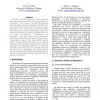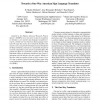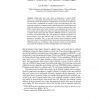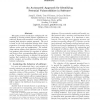249 search results - page 18 / 50 » The Belief-Desire-Intention Model of Agency |
HICSS
2003
IEEE
14 years 28 days ago
2003
IEEE
This paper asks how internet use, citizen satisfaction with e-government and citizen trust in government are interrelated. Prior research has found that agencies stress informatio...
FGR
2004
IEEE
13 years 11 months ago
2004
IEEE
Inspired by the Defense Advanced Research Projects Agency's (DARPA) recent successes in speech recognition, we introduce a new task for sign language recognition research: a ...
DSS
2006
13 years 7 months ago
2006
In law enforcement applications, there is a critical need for new tools that can facilitate efficient and effective collaboration. Through a field study, we observe that crime ana...
KI
2008
Springer
13 years 7 months ago
2008
Springer
Abstract. Modal logics see a wide variety of applications in artificial intelligence, e.g. in reasoning about knowledge, belief, uncertainty, agency, defaults, and relevance. From ...
SP
1998
IEEE
13 years 12 months ago
1998
IEEE
This paper presents results from analyzing the vulnerability of security-critical software applications to malicious threats and anomalous events using an automated fault injectio...




